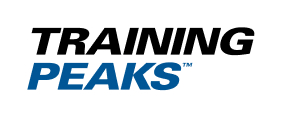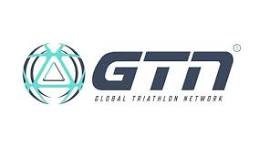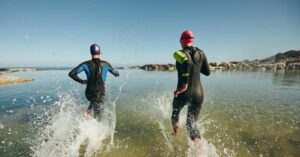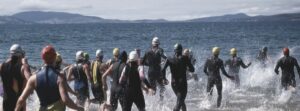Considering an IRONMAN triathlon? Learn the distances and other key facts…
An IRONMAN triathlon has a total race distance of 140.6 miles (or 226.2 kilometres). You’ll burn through 10,000 calories and, for some, over 130,000 beats of the heart.
Yes, an IRONMAN 140.6 triathlon is arguably the toughest, most demanding one-day sporting event on the planet. Those of you who’ve tentatively taken their first dip into sprint-distance waters will feel this behemoth of a challenge is beyond you; it’s an impossible challenge only completed by those who’ve got 20-plus hours every week to train and can R&R with the diligence of a sloth, you might think.
It’s not. Yes, dedication is required but hey, you’re a triathlete – you’ve already slipped that into your tri-suit’s rear pocket. All of you can cross that iron finish line, but before I show you how, it’s time to clear up some naming anomalies.
IRONMAN 140.6, Long-Course, Long Distance – Which Is It?
IRONMAN, as many people identify the race distance of 3.8km swim, 180km bike and 42.2km run, is actually a trademark. IRONMAN the brand is owned by Advance, an American media company, who bought it in 2020 for $730 million.
While IRONMAN is the most well-known brand – in particular, the IRONMAN World Championships held in Hawaii every year – there are other race organisers doing a fine job.
The Challenge group’s Roth event in Germany, for instance, attracts hundreds of thousands of spectators, making it more akin to a Tour de France stage. It’s the same debilitating distance but is called “long-course” or “long-distance” rather than IRONMAN. Do that and the lawyers of Advance will come knocking!
What’s a Good Time for an IRONMAN 140.6?
How long does it take to complete an IRONMAN 140.6, long-course, full distance…?
The multi-disciplinary nature of triathlon, plus transitions, means there are many variables at play. We’ll dig deep into those shortly but, as an average, according to analysis outfit Runtri.com who dissected the times of 41,000 finishers, you’re looking at 12 hours and 35 minutes.
That’s arguably near enough the median time, too, with many overall winners – certainly in the men’s category – crossing the line in eight hours, while the cut-off time is 17 hours.
Eight hours is incredibly fast, albeit not quite as swift as German triathlete Jan Frodeno’s exploits at Challenge Roth in 2016. The 2008 Olympic triathlon gold medallist clocked a 45:22 swim, 4:09:22 bike and 2:40:35 run en route to a world record of 7:35:39. Britain’s Chrissie Wellington holds the women’s record of 8:18:13, again set at Challenge Roth in 2011.
Why is Roth the go-to place when it comes to setting new benchmarks? That comes down to its parcours. Here, I’ll run through the Roth swim, bike and run, highlighting why it’s so fast, and also show you what other bodies of water, mountainous bikes and technical runs await elsewhere.
The 3.8km Swim
In Roth, rather unusually the swim takes place in a canal. This creates a threefold stimulus for a rapid opening leg. The first is that it’s as calm as a, well, canal. Next, the narrow channel naturally provides shoreline guides as markers, meaning there are minimal issues around sighting. Finally, there’s the support. Twenty-thousand people line the canal, boosting your adrenaline levels and sending you surging through the water.
Away from Roth, long-course swims often unfold in the sea, whether it’s the two-loop effort in Carmarthen Bay at IRONMAN Wales or the one-lap crawl around Kailua Bay at IRONMAN Hawaii.
Full-distance swims also take place in lakes, and are a good entry for triathletes who aren’t uber-confident in the water. The lack of waves or current means you can keep you and your head as low possible and so remain streamlined.
Occasionally, but rarely, it’ll be a river swim where you’ll face a current. Just remember to place yourself nearer the slower-moving waters near the banks upstream and in the middle downstream, where the water’s deepest and fastest.
The 180km Bike
It’s rather ironic that one of the key features of the Roth bike course is the Solarberg, or Solar Hill, where tens of thousands of fervent fans assemble in honour of yours and your race-mates’ presence.
In actual fact, the two-loop bike course is predominantly flat with a few rolling sections and a smattering of punchy ascents like the Solarberg. Overall, elevation nestles between 350m and 550m above sea level. It’s also pretty straight, so little time is lost braking into corners, and the roads are as smooth as an eel.
If you’re looking to rack up climbing metres rather than speed, there are few tougher IRONMAN bike legs than Lanzarote where you’ll face over 2,500m of ascending. Throw in the island’s notorious sweeping winds and a tough day is guaranteed. Just make sure you have enough gears to avoid pushing your bike. And aim to improve your power-to-weight ratio by losing a few pounds and ticking off hills reps in training. You’ll appreciate it come the Canaries.












